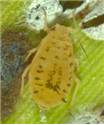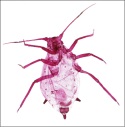Classification
Aphidinae: Aphidini
Common name(s)
Sugarcane aphid, yellow sugarcane aphid, green sugarcane aphid, cane aphid, sorghum aphid
Diagnosis
This aphid is greatly variable in colour depending on the host plant and environmental conditions; pale-yellow, yellow-brown, dark-brown, purple, or pink; small, always attended by large number of ants. Fully-grown nymphs may have scattered brown patches, randomly distributed on abdominal tergum; sometimes intersegmental lines are marked brown. Body 12-13x as long as siphunculi. Antennae usually six- and rarely five-segmented, about half as long as body (in larger specimens antennae much longer). Processus terminalis 4-5x longer than base of last antennal segment. Cauda pale in contrast to brown siphunculi.
The infestation starts from the central whorl and later spreads to the leaf surface. The aphids are usually found on the upper surface of the leaves.
Distribution
Cosmopolitan. Allover South India.
Host plant(s)
Poaceae: Pennisetum glaucum R. Br., Saccharum officinarum L., Sorghum bicolor (L.) Moench., Zea mays L.
Measurements
Aptera: Length of body 1.55, width 0.89; antennae 0.81, segments III: IV: V: VI 0.22: 0.17: 0.17: (0.07+0.36); u.r.s. 0.09; h.t.2 0.11; siphunculus 0.12; cauda 0.16.
Alata: Length of body 1.89, width 0.91; antennae 1.00, segments III: IV: V: VI 0.24: 0.22: 0.23: (0.11+0.37); u.r.s. 0.09; h.t.2 0.09; siphunculus 0.09; cauda 0.10.
Seasonal occurrence
January-March and June-August.
Natural enemies
Coleoptera: Coccinellidae: Cryptogonus quadriguttatus (Weise), Scymnus (Pullus) castaneus Sicard.
Hymenoptera: Aphelinidae: Aphelinus desantisi Hayat.
Diptera: Syrphidae: Allograpta javana (Wiedemann), Eumerus sp. nr. albifrons Walker, Paragus serratus (F.), P. tibialis (Fallen), P. yerburiensis Stuckenberg, Ischiodon scutellaris (F.), Episyrphus balteatus (De Geer), Sphaerophoria ?indiana Bigot.
_sml.jpg)

_sml.jpg)
_sml.jpg)
_sml.jpg)
_sml.jpg)
_sml.jpg)
_sml.jpg)
_sml.jpg)
_sml.jpg)

